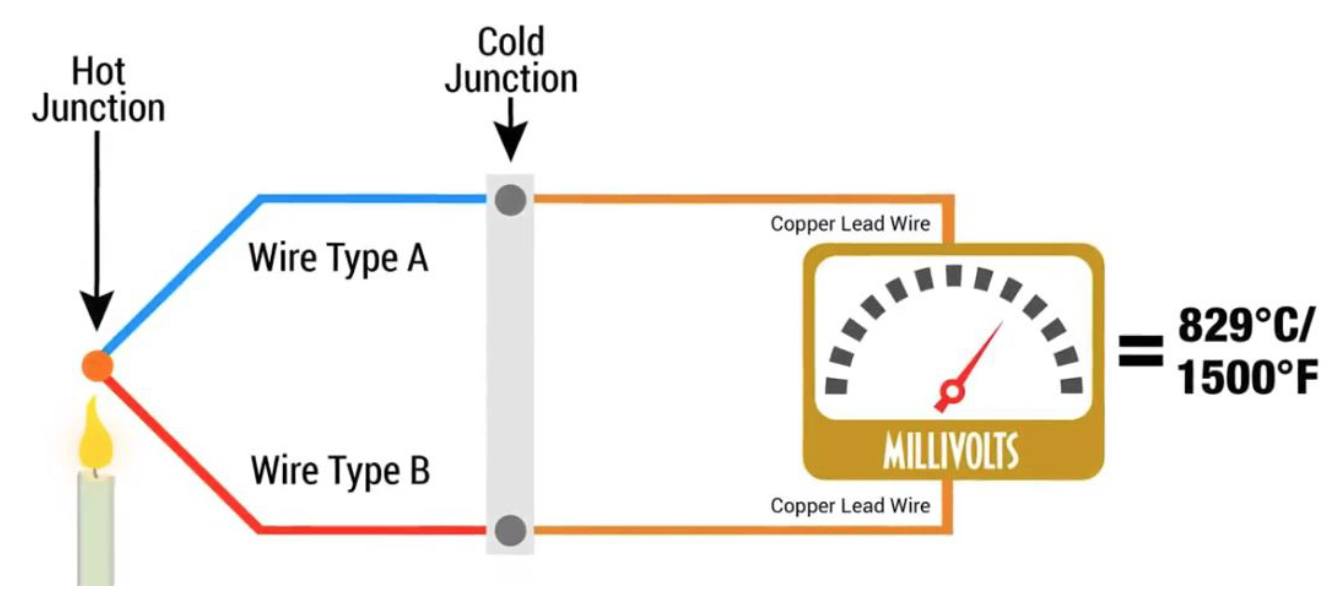Math Is Fun Forum
You are not logged in.
- Topics: Active | Unanswered
Pages: 1
#1 2025-04-24 16:20:10
- Jai Ganesh
- Administrator

- Registered: 2005-06-28
- Posts: 52,732
Thermocouple
Thermocouple
Gist
A thermocouple, a temperature-measuring device consisting of two wires of different metals joined at each end. One junction is placed where the temperature is to be measured, and the other is kept at a constant lower temperature.
Summary
A thermocouple, a temperature-measuring device consisting of two wires of different metals joined at each end. One junction is placed where the temperature is to be measured, and the other is kept at a constant lower temperature. A measuring instrument is connected in the circuit. The temperature difference causes the development of an electromotive force (known as the Seebeck effect) that is approximately proportional to the difference between the temperatures of the two junctions. Temperature can be read from standard tables, or the measuring instrument can be calibrated to read temperature directly.
Any two different metals or metal alloys exhibit the thermoelectric effect, but only a few are used as thermocouples—e.g., antimony and bismuth, copper and iron, or copper and constantan (a copper-nickel alloy). Usually platinum, either with rhodium or a platinum-rhodium alloy, is used in high-temperature thermocouples. Thermocouple types are named (e.g., type E [nickel, chromium, and constantan], J [iron and constantan], N [two nickel-silicon alloys, one of which contains chromium and magnesium], or B [a platinum-rhodium alloy]) according to the metals used to make the wires. The most common type is K (nickel-aluminum and nickel-chromium wires) because of its wide temperature range (from about −200 to 1,260 °C [−300 to 2,300 °F]) and low cost.
A thermopile is a number of thermocouples connected in series. Its results are comparable to the average of several temperature readings. A series circuit also gives greater sensitivity, as well as greater power output, which can be used to operate a device such as a safety valve in a gas stove without the use of external power. a temperature-measuring device consisting of two wires of different metals joined at each end. One junction is placed where the temperature is to be measured, and the other is kept at a constant lower temperature.
Details
A thermocouple, also known as a "thermoelectrical thermometer", is an electrical device consisting of two dissimilar electrical conductors forming an electrical junction. A thermocouple produces a temperature-dependent voltage as a result of the Seebeck effect, and this voltage can be interpreted to measure temperature. Thermocouples are widely used as temperature sensors.
Commercial thermocouples are inexpensive, interchangeable, are supplied with standard connectors, and can measure a wide range of temperatures. In contrast to most other methods of temperature measurement, thermocouples are self-powered and require no external form of excitation. The main limitation with thermocouples is accuracy; system errors of less than one degree Celsius (°C) can be difficult to achieve.
Thermocouples are widely used in science and industry. Applications include temperature measurement for kilns, gas turbine exhaust, diesel engines, and other industrial processes. Thermocouples are also used in homes, offices and businesses as the temperature sensors in thermostats, and also as flame sensors in safety devices for gas-powered appliances.
Principle of operation
In 1821, the German physicist Thomas Johann Seebeck discovered that a magnetic needle held near a circuit made up of two dissimilar metals got deflected when one of the dissimilar metal junctions was heated. At the time, Seebeck referred to this consequence as thermo-magnetism. The magnetic field he observed was later shown to be due to thermo-electric current. In practical use, the voltage generated at a single junction of two different types of wire is what is of interest as this can be used to measure temperature at very high and low temperatures. The magnitude of the voltage depends on the types of wire being used. Generally, the voltage is in the microvolt range and care must be taken to obtain a usable measurement. Although very little current flows, power can be generated by a single thermocouple junction. Power generation using multiple thermocouples, as in a thermopile, is common.
Additional Information
A thermocouple is a sensor for measuring temperature. This sensor consists of two dissimilar metal wires, joined at one end, and connected to a thermocouple thermometer or other thermocouple-capable device at the other end. When properly configured, thermocouples can provide temperature measurements over wide range of temperatures.
Thermocouples are known for their versatility as temperature sensors therefore commonly used on a wide range of applications - from an industrial usage thermocouple to a regular thermocouple found on utilities and regular appliances. Due to their wide range of models and technical specifications, it is extremely important to understand its basic structure, how it works, its ranges as to better determine what is the right type and material of thermocouple for your application.

It appears to me that if one wants to make progress in mathematics, one should study the masters and not the pupils. - Niels Henrik Abel.
Nothing is better than reading and gaining more and more knowledge - Stephen William Hawking.
Offline
Pages: 1